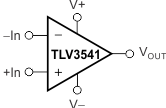SBOS756 October 2016 TLV3541 , TLV3542 , TLV3544
PRODUCTION DATA.
- 1 Features
- 2 Applications
- 3 Description
- 4 Revision History
- 5 Pin Configuration and Functions
- 6 Specifications
- 7 Detailed Description
- 8 Application and Implementation
- 9 Power Supply Recommendations
- 10Layout
- 11Device and Documentation Support
- 12Mechanical, Packaging, and Orderable Information
Package Options
Mechanical Data (Package|Pins)
Thermal pad, mechanical data (Package|Pins)
Orderable Information
1 Features
- Wide-Bandwidth Amplifier for Cost-Sensitive Systems
- Unity-Gain Bandwidth: 200 MHz
- High Slew Rate: 150 V/μs
- Low Noise: 7.5 nV/√Hz
- Rail-to-Rail I/O
- High Output Current: > 100 mA
- Excellent Video Performance:
- Diff Gain: 0.02%, Diff Phase: 0.09°
- 0.1-dB Gain Flatness: 40 MHz
- Low Input Bias Current: 3 pA
- Quiescent Current: 5.2 mA
- Thermal Shutdown
- Supply Range: 2.5 V to 5.5 V
2 Applications
- High-Resolution ADC Driver Amplifiers
- IR Touch
- Low-Voltage, High-Frequency Signal Processing
- Video Processing
- Base Transceiver Stations
- Optical Networking, Tunable Lasers
- Photodiode Transimpedance Amplifiers
- Barcode Scanners
- Fast Current-Sensing Amplifiers
- Ultrasound Imaging
 Figure 1. Simplified Schematic
Figure 1. Simplified Schematic
3 Description
The TLV3541, TLV3542 and TLV3544 are single-, dual-, and quad-channel, low-power (5.2-mA per channel), high-speed, unity-gain stable, rail-to-rail input/output operational amplifiers (op amps) designed for video and other applications that require wide bandwidth.
Consuming only 6.5 mA (maximum) of supply current, these devices feature 200-MHz gain-bandwidth product, 150-V/μs slew rate, and a low 7.5 nV/√Hz of input noise at f = 1 MHz. The combination of high bandwidth, high slew rate, and low noise make the TLV354x family suitable for low voltage, high-speed signal conditioning systems.
The TLV354x series of op amps are optimized for operation on single or dual supplies as low as 2.5 V (±1.25 V) and up to 5.5 V (±2.75 V). Common-mode input range extends beyond the supplies. The output swing is within 100 mV of the rails, and supports a wide dynamic range.
The TLV354x devices are specified from –40°C to +125°C. The TLV354x family can be used as a plug-in replacement for many commercially available wide bandwidth op amps.
Device Information(1)
| PART NUMBER | PACKAGE | BODY SIZE (NOM) |
|---|---|---|
| TLV3541 | SOIC (8) | 3.91 mm × 4.90 mm |
| SOT-23 (5) | 2.90 mm × 1.60 mm | |
| TLV3542 | SOIC (8) | 3.91 mm × 4.90 mm |
| VSSOP (8) | 3.00 mm × 3.00 mm | |
| TLV3544 | SOIC (14) | 8.65 mm × 3.91 mm |
| TSSOP (14) | 5.00 mm × 4.40 mm |
- For all available packages, see the orderable addendum at the end of the data sheet.
4 Revision History
| DATE | REVISION | NOTES |
|---|---|---|
| October 2016 | * | Initial release. |